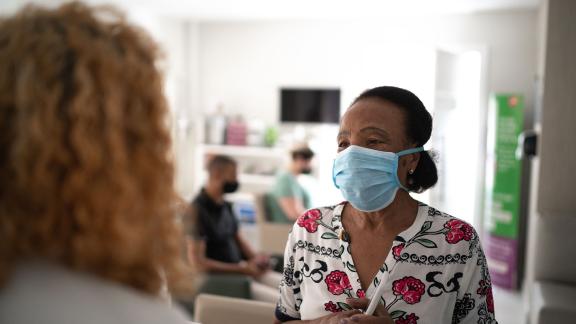Surrey Growing Health Together

Surrey Growing Health Together is a dynamic, collaborative and inclusive model that centres on the voice and agency of community members to improve neighbourhood health and wellbeing through both upstream approaches and improvements to the delivery of clinical care
The neighbourhood
Growing Health Together operates across East Surrey Place, which has a neighbourhood model involving five neighbourhoods each with populations of roughly 8,000 to 25,000 people. The geography of the neighbourhoods have been defined through workshops and conversations with the communities they serve, acknowledging that PCN footprints do not map onto how neighbourhoods self-identify.
Each neighbourhood has a minimum of one GP surgery, which is a key asset for the work. Management and governance support sits with the GP federation, PCN and NHS Surrey Heartlands. Each neighbourhood has the freedom to pursue activities and initiatives that respond to health and wellbeing needs defined by their community.
The area covered by Growing Health Together is a mix of rural and urban. One area in the geography is in the most deprived 20 per cent of the country while the rest of the area does not exhibit characteristics of high deprivation.
The context
Growing Health Together came from the observation that many interactions with GPs involved solving problems that they did not have the levers to resolve, nor could they deal with the determinants of the root causes. Dealing with these wider determinants required a new approach based on listening to communities and working together to create local conditions for health and wellbeing.
The approach recognises that primary care services cannot meet these challenges alone given their stretched capacity. A key aim is to ease pressures in the system by reducing the level of ill health in the community , in collaboration with partners from local authorities, schools, VCSE sector, faith sector, businesses and community members themselves.
Growing Health Together was established initially in Horley, and then spread to surrounding neighbourhoods to address these wider determinants.
The model
The model began with active listening by GPs to people’s views on the barriers to health in their neighbourhood, in GP appointments and other fora, followed by relationship building with community members and partners who wanted to work together to overcome these. Support from The Alliance for Better Care GP Federation and PCNs was critical to getting the programme going.
Central characteristics of the model include listening, inclusion and shifting power and resources to enable community-led solutions that support upstream prevention, health creation and early intervention.
Each neighbourhood has autonomy to co-design and co-deliver initiatives and activities that respond to their specific needs, allowing flexibility at a neighbourhood level and space for local, distributed leadership.
The model is funded and assured through the PCN, GP federation and East Surrey Health and Care Partnership board. Each neighbourhood has a lead GP who convenes a health and wellbeing network for that neighbourhood. The network includes a wide range of partners, including residents, local schools, police and other health services, who work together to improve local population health.
The model uses elements of different approaches, including ABCD and health creation. The model aspires to support community-led health creation and improvements in clinical care, through connecting primary care with community members and partners at a neighbourhood level. A named GP has protected time to work on Growing Health Together in each neighbourhood of East Surrey. Funding is secured through host PCNs and NHS Surrey Heartlands.
What makes this effective and resilient
The resilience of the model is drawn from the establishment of health and wellbeing networks in each neighbourhood involving statutory and non-statutory partners. These are a formalised part of the governance structure of NHS Surrey Heartlands in East Surrey Place, and they meet quarterly to discuss and respond to emerging issues and opportunities to improve local health and wellbeing.
An approach by professionals marked by humility, and a willingness to learn and respond to residents as equal partners. Anyone living or working in one of the five neighbourhoods can attend their local health and wellbeing network as equal partners in improving neighbourhood health and wellbeing.
“We have a home now, we have a place where we go to, where they will always listen.”
Resident
Health and wellbeing networks support local accountability and help the system to respond effectively to local needs. For example, school heads voiced concerns on dental health at a health and wellbeing network. These were then escalated to NHS Surrey Heartlands’ dental lead, who was able to respond accordingly. The involvement of a broad range of statutory and non-statutory partners gives this model legitimacy and power at a local level.
Growing Health Together funds many small-scale activities and groups that are generated through neighbourhood need. Some examples including exercise classes for frail residents, a 'men in sheds' initiative to reduce loneliness and projects with schools and care homes supporting improved physical activity, social connection and creative health.
What makes this challenging
Securing funding to evaluate impact and project manage the initiative has been a challenge.
Working across organisational boundaries and different organisational cultures introduces challenges in standardisation and level of commitment. There is a sense that real traction of the model sometimes relies on individuals within the community or partner organisations.
Impact and outcomes
Body weight fell in 83 per cent of patients attending an inclusive exercise class, HbA1c fell in 60 per cent, and GP consultation frequency fell in 62 per cent of attendees studied.
An independent evaluation of Growing Health Together is underway led by the University of Kent, funded by NIHR-Applied Research Collaboration, Kent, Surrey and Sussex, using a mixed-methods design. Outputs are expected by the end of 2024.
“Yes, things are still hard. But we have a sense of possibility, hope, invigoration even.”
Dr Gillian Orrow, Growing Health Together.
Further information on this case study:



